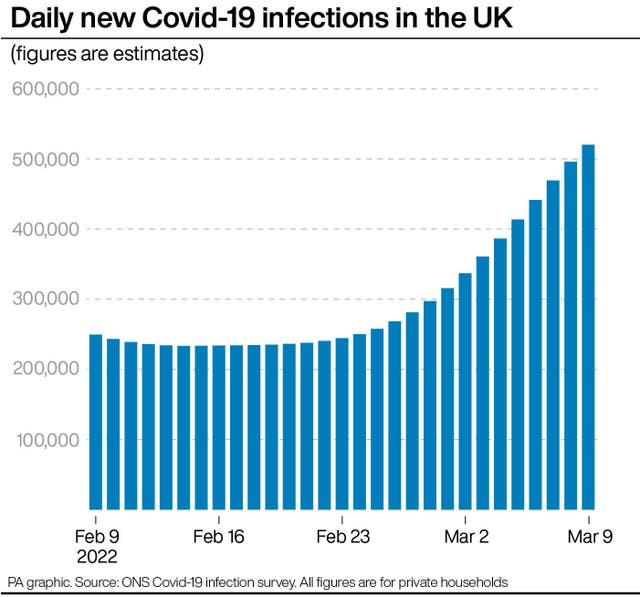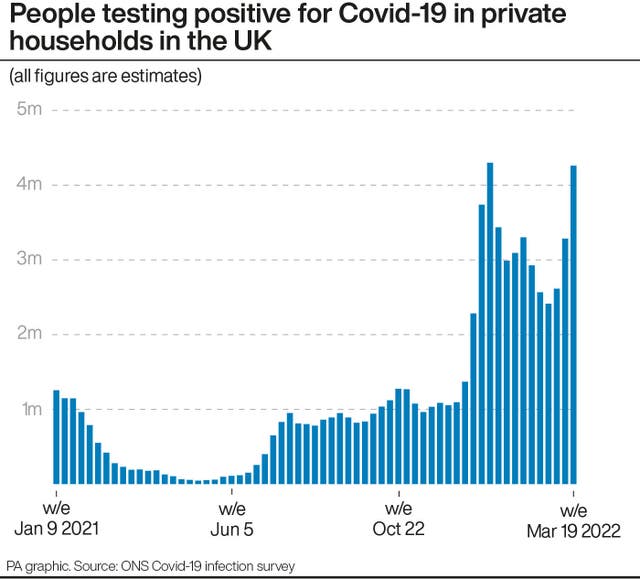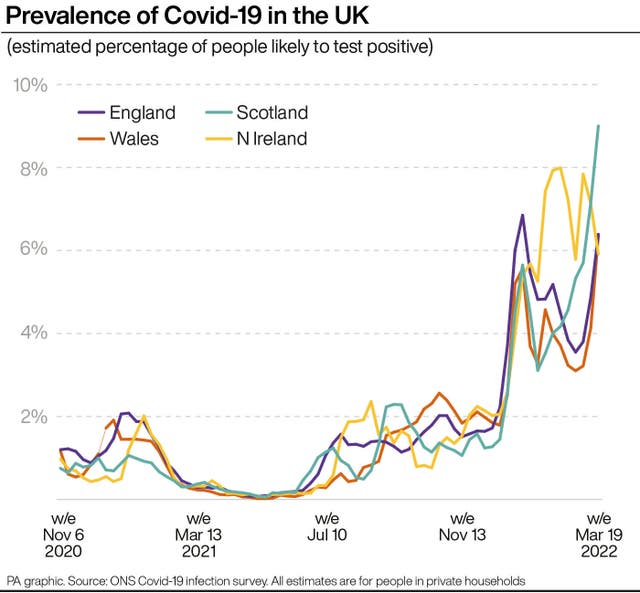Covid-19 infections have risen sharply across most of the UK and are nearing record levels in England, while both Scotland and Wales have reached an all-time high, new figures show.
Across the UK as a whole, 4.26 million people were likely to have had coronavirus last week – just short of the 4.30 million in the first week of 2022, which was the highest total since estimates began.

Northern Ireland is the only nation where infections are believed to be falling, with levels having dropped for two weeks in a row, according to the Office for National Statistics (ONS).
The steep rise in infections across much of the country is being driven by the Omicron BA.2 variant, a more transmissible form of Omicron, the ONS said.
The figures are further evidence that Covid-19 is becoming rapidly more prevalent in the UK and come as the number of people in hospital with the virus continues to increase.

Around one in 16 people in private households in England – or 3.5 million people – are likely to have had Covid-19 in the week to March 19.
This is up from one in 20, or 2.7 million people, in the previous week and is the third week in a row that infections are estimated to have risen.
Wales has also seen its third successive jump in infections, with the figure up from 125,400 people, or one in 25, to 192,900 people, or one in 16: a record high.
In Scotland, infections have now risen for eight weeks in a row and have also reached another record high, with nearly half a million people (473,800) likely to have had Covid-19 last week, or one in 11. This is up from 376,300 people, or one in 14, the previous week.
But in Northern Ireland infections have fallen for the second successive week and now stand at an estimated 108,700 people, or one in 17, down from 130,600 people, or one in 14.

The percentage of people testing positive for Covid-19 in England has increased across all age groups and regions, the ONS found.
Infection levels among over-70s remain at their highest since estimates began in England in May 2020, with around one in 20 (5.0%) likely to have the virus, up week-on-week from one in 30 (3.5%).
Covid-19 remains most prevalent among young children, however.
Around one in 12 (8.3%) of those aged between two and school year 6 are estimated to have had coronavirus last week, up from one in 16 (6.3%).
#COVID19 infections increased across all age groups in the week ending 19 March 2022 https://t.co/zjZZxROXBX pic.twitter.com/ZNDYBdFFyy
— Office for National Statistics (ONS) (@ONS) March 25, 2022
The ONS infection survey is the most reliable measure of the prevalence of Covid-19 in the UK.
It uses a representative sample of swab tests collected regularly from tens of thousands of households, and is therefore able to estimate the percentage of people likely to test positive for Covid-19 at any one point in time, regardless of when they caught the virus, how many times they have had it and whether they have symptoms.
The survey is far more representative of the level of Covid-19 in the UK than the number of cases announced each day by the Government, which includes only those people who have reported themselves as testing positive for the virus, and is affected by how many people are coming forward for tests or who are taking a test because they know they have coronavirus symptoms.
James Naismith, professor of structural biology at Oxford University, warned the latest ONS figures showed there is “no sign yet” that the virus has peaked.
“Politicians at the UK and devolved levels have all decided as a practical matter to let the virus spread through the population,” he said.
“The sheer scale of the infection is now pressuring the health service, but the combination of vaccination, improved treatments and the less severe nature of Omicron means for the vast majority of those infected this will not be life threatening.
“This wave will burn out simply by infecting all those who can be infected.”
Dr Stephen Griffin, professor of medicine at the University of Leeds, said the combination of the BA.2 variant and the relaxation of Covid restrictions is “causing a massive resurgence of infection” with a “worrying” spread among older age groups.
He added: “Blinding ourselves to this level of harm does not constitute living with a virus infection, quite the opposite. Public health has seemingly dropped dramatically on the list of this Government’s priorities, to the detriment of the UK population as a whole.”

A total of 16,975 people with Covid-19 were in hospital in the UK on March 23, up 18% on the previous week and the highest number since January 24.
But this is still below the level seen at the peak of the original Omicron wave on January 10 (20,048) and well below the peak reached during the second wave of the virus in January 2021 (39,255).
Separate figures from NHS England show that just over half of all patients in hospital with Covid-19 are being treated primarily for something else, up from a quarter in autumn 2021.
All patients who have tested positive for Covid-19 need to be treated separately from those who do not have the virus, regardless of whether they are in hospital primarily for Covid or not.
But the proportion of patients who are in hospital “with” Covid-19 rather than “for” Covid-19 – 55% as of March 22 – is another sign that the current wave of the virus has not led to the same sort of pressure on critical care as in previous waves.




Comments & Moderation
Readers’ comments: You are personally liable for the content of any comments you upload to this website, so please act responsibly. We do not pre-moderate or monitor readers’ comments appearing on our websites, but we do post-moderate in response to complaints we receive or otherwise when a potential problem comes to our attention. You can make a complaint by using the ‘report this post’ link . We may then apply our discretion under the user terms to amend or delete comments.
Post moderation is undertaken full-time 9am-6pm on weekdays, and on a part-time basis outwith those hours.
Read the rules here